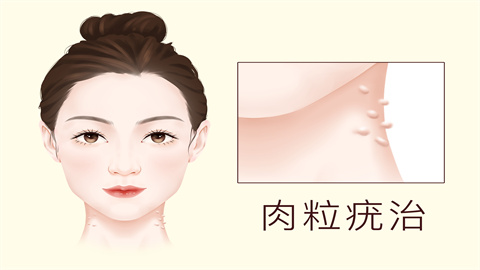What causes warts on the neck?
Generally, warts appearing on the neck may be caused by damaged skin barrier, decreased immunity, genital warts, seborrheic keratosis, contagious molluscum, and other factors. If discomfort occurs, timely treatment at a regular hospital is recommended. Detailed explanations are as follows:
1. Skin Barrier Damage
Long-term irritation such as friction and sun exposure on the neck skin can damage the skin barrier function, making it susceptible to external pathogens and increasing the likelihood of developing warts. Daily protection of the neck skin should be maintained by avoiding frequent friction, applying sunscreen when outdoors, and using gentle skincare products to moisturize the skin.
2. Decreased Immunity
Factors such as long-term sleep deprivation, excessive fatigue, and malnutrition can reduce the body's immunity, preventing the immune system from effectively resisting pathogens, thus leading to the appearance of warts on the neck. It is necessary to adjust lifestyle habits, ensure sufficient sleep, maintain a balanced diet rich in vitamins and proteins, and engage in appropriate physical exercise to enhance immunity.

Human papillomavirus can enter epithelial cells through microscopic skin or mucosal injuries and replicate, leading to abnormal differentiation and proliferation of epithelial cells, causing genital warts. Under a doctor's guidance, medications such as imiquimod cream, fluorouracil cream, and recombinant human interferon α2b gel can be used for treatment. Physical removal methods such as cryotherapy and laser therapy are also options.
4. Seborrheic Keratosis
With aging and skin degeneration, seborrheic keratosis may appear on the neck, presenting as light brown or black wart-like papules. Generally, no treatment is required unless they affect appearance. In such cases, removal methods such as laser therapy, electrocautery, or cryotherapy can be performed under a doctor's supervision.
5. Contagious Molluscum
Infection with the molluscum contagiosum virus can cause hemispherical papules on the neck, with a waxy luster on the surface and a central umbilication, which may also appear wart-like. Under a doctor's guidance, treatments such as excision of the wart or laser therapy can be used. After treatment, topical application of antibiotics like mupirocin ointment, fusidic acid cream, or erythromycin ointment can be used to prevent infection.
In daily life, maintaining clean and dry neck skin is important; scratching the warts should be avoided to prevent self-inoculation and transmission. Personal items such as towels and clothing should be washed and disinfected separately. Avoid sharing personal items with others to prevent cross-infection. If the number of warts increases or discomfort such as pain or itching occurs, seek medical attention promptly.







